-
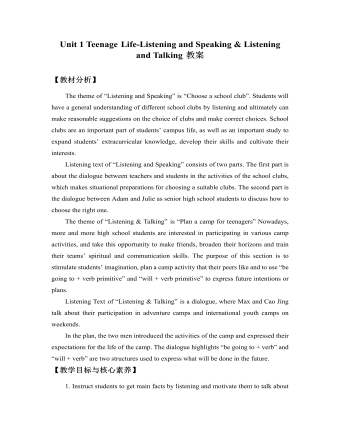
新人教版高中英语必修1Unit 1 Teenage Life-Listening and Speaking & Listening and Talking教案
Step 2 Listening and Talking1. The teacher is advised to talk with their new students about the related topic: Boys and girls, do you know some structures to talk about future activities? Talking about future activitiesWe’ll …I plan to …There’ll be …I hope to …We’re going to …2. After their small talk, the teacher can move on by playing the listening and solve the following task.Underline the expressions in the sentences below Cao Jing and Max use to talk about the future.We’ll learn useful skills.I plan to improve my spoken English.There’ll be students from different schools.I hope to make new friends.We’ll talk about teenage life.I’ll learn to make a fire.There’ll be students from different countries at the camp.There’ll be some experts there to show us how to live in the wild.We’re going to learn about wildlife.I’m going to give a speech.I think I’m going to enjoy the activities.I think we’ll have a lot of fun.3. Work in groups. Plan a youth camp.Teacher make the Ss think of ideas for the camp. And they can use the questions below to get started. And have the Ss present their ideas for a youth camp to the class.●What kind of camp is it?●Who will be there?●What will they do?●What will they learn?
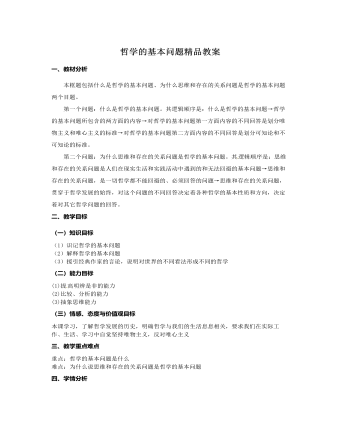
人教版高中政治必修4哲学的基本问题精品教案
一、教材分析本框题包括什么是哲学的基本问题、为什么思维和存在的关系问题是哲学的基本问题两个目题。第一个问题:什么是哲学的基本问题。其逻辑顺序是:什么是哲学的基本问题→哲学的基本问题所包含的两方面的内容→对哲学的基本问题第一方面内容的不同回答是划分唯物主义和唯心主义的标准→对哲学的基本问题第二方面内容的不同回答是划分可知论和不可知论的标准。第二个问题:为什么思维和存在的关系问题是哲学的基本问题。其 逻辑顺序是:思维和存在的关系问题是人们在现实生活和实践活动中遇到的和无法回避的基本问题→思维和存在的关系问题,是一切哲学都不能回避的、必须回答的问题→思维和存在的关系问题,贯穿于哲学发展的始终,对这个问题的不同回答决定着各种哲学的基本性质和方向,决定着对其它哲学问题的回答。 二、教学目标(一)知识目标(1)识记哲学的基本问题(2)解释哲学的基本问题
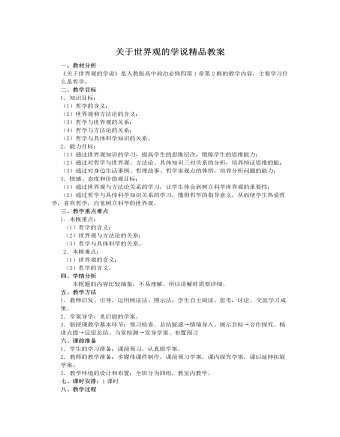
人教版高中政治必修4关于世界观的学说精品教案
一、教材分析《关于世界观的学说》是人教版高中政治必修四第1章第2框的教学内容,主要学习什么是哲学。二、教学目标1.知识目标:(1)哲学的含义;(2)世界观和方法论的含义;(3)哲学与世界观的关系;(4)哲学与方法论的关系;(5)哲学与具体科学知识的关系。2.能力目标:(1)通过世界观知识的学习,提高学生的思维层次,锻炼学生的思维能力;(2)通过对哲学与世界观、方法论、具体知识三对关系的分析,培养辩证思维的能;(3)通过对身边生活事例、哲理故事、哲学家观点的体悟,培养分析问题的能力;3.情感、态度和价值观目标:(1)通过世界观与方法论关系的学习,让学生体会到树立科学世界观的重要性;(2)通过哲学与具体科学知识关系的学习,懂得哲学的指导意义,从而使学生热爱哲学,喜欢哲学,自觉树立科学的世界观。
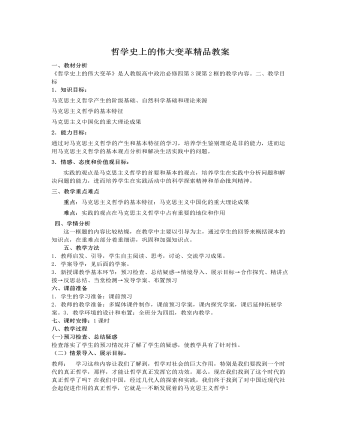
人教版高中政治必修4哲学史上的伟大变革精品教案
一、教材分析《哲学史上的伟大变革》是人教版高中政治必修四第3课第2框的教学内容。二、教学目标1.知识目标:马克思主义哲学产生的阶级基础、自然科学基础和理论来源马克思主义哲学的基本特征马克思主义中国化的重大理论成果2.能力目标:通过对马克思主义哲学的产生和基本特征的学习,培养学生鉴别理论是非的能力,进而运用马克思主义哲学的基本观点分析和解决生活实践中的问题。3.情感、态度和价值观目标:实践的观点是马克思主义哲学的首要和基本的观点,培养学生在实践中分析问题和解决问题的能力,进而培养学生在实践活动中的科学探索精神和革命批判精神。三、教学重点难点重点:马克思主义哲学的基本特征;马克思主义中国化的重大理论成果
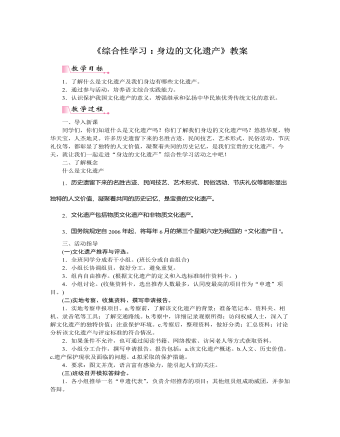
部编版语文八年级上册《综合性学习:身边的文化遗产》教案
当汽车行驶在乡间小道时,作家冯骥才再也没有了写作的冲动。往日白砖青瓦的农舍冒出了西洋式的尖顶和闪着异光的马赛克,炊烟袅袅,小桥流水成了埋藏在心底的梦。冯先生开始四处奔波,大声疾呼:救救我们的文化遗产!中国文化博大而宽广。她无处不在——融于书本,徜徉于江南小道,盘旋在峭壁飞檐……我们被这种浓厚的文化信息包围着,却道貌岸然地做着刽子手。忘记历史就是背叛。我们的文化遗产是历史的见证。秦始皇的兵马俑至今气宇轩昂地挺立着,隋朝大运河的波澜依旧拍打着千年的岸堤……孟江女的哭声凄婉悲恸,纤夫的号子似乎仍在耳边萦绕。沉淀了千年的沉浮、繁华、屈辱、悲愤,这些文化遗产烫帖了坎坷的心灵,将肃穆呈于世人。刀光剑影去了,长歌悲哭停止了,豪情厮杀消逝了……一切随着大江东去,只有千年松柏和着轻风耳语。
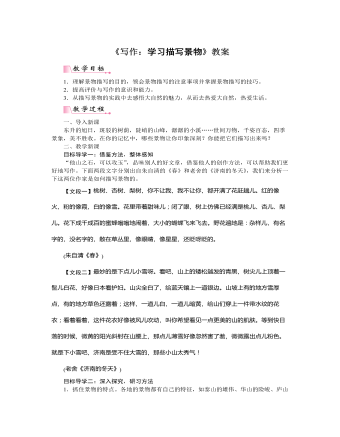
部编版语文八年级上册《写作:学习描写景物》教案
5.发挥想象。两段文字都运用了想象的手法。“闭了眼,树上仿佛已经满是桃儿、杏儿、梨儿”“看着看着,这件花衣好像被风儿吹动,叫你希望看见一点更美的山的肌肤”“那点儿薄雪好像忽然害了羞”,这些想象,既突出了景物的特点,又融入了作者的情感,可谓是一举两得。6.讲究描写的顺序。两段文字都采用空间顺序展开描写,景物的层次清晰。要注意观察的顺序,是由近及远,还是由远及近?是由上到下,还是由下到上?这是指空间的变换。还可以以时间的变化或游览的先后为顺序。这样,所描写的景物才不会杂乱无章。7.写景还要融入情感。“一切景语皆情语”。写景贵有情,在描绘客观景物的同时,要把自己的喜怒哀乐等思想感情融注到作品中去,使读者产生共鸣,进而给读者带来愉悦之情、陶醉之情,将读者带入特定的情景之中,受到美的熏陶,获得美的享受。如《从百草园到三味书屋》中“夏天百草园”一段“油蛉在这里低唱,蟋蟀们在这里弹琴”,在作者小时候听来,油蛉、蟋蟀的叫声犹如人在悠扬的琴声伴奏下婉转地低唱,其间传递着作者愉快、喜悦的心声,表达作者对大自然的喜爱和向往之情。目标导学三:实战演练描写你家乡一处有特色的景物,包括自然景物和社会景物,要求描写细致、生动,表达你对家乡的热爱之情。例文展示:

部编版语文八年级下册《综合性学习:古诗苑漫步》教案
【目标导航】1.主动学习欣赏、演唱古诗词,在反复吟诵中进一步体会中华诗词文化的灿烂辉煌;2.漫步古诗苑,领略多姿多彩的创作风格,了解明星璀璨的大家名人,浏览醒世鉴人的名篇佳句,体会博大精深的思想内容,感知美妙绝伦的艺术特色;3.激励参与意识和创新精神,能借助诗歌抒发真情实感,濡染心灵,陶冶性情,培养文学纯正趣味,提高参与者的文学综合素养。【课时安排】1课时自由组成小组,搜集相关资料,通过多种手段如多媒体,学生绘画,音乐等课程资源,为学生创设优美的教学情境。【新课导入】中国是一个诗的国度,中华诗词是民族文化的宝典,是一朵瑰丽的文学奇葩。今天,让我们就漫步在这个色彩缤纷的世界,在鸟语花香中,品味古人的闲情逸致,在诗情画意中,学习他们的旷达胸襟。
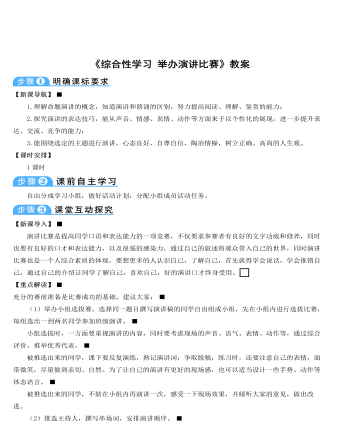
部编版语文八年级下册《综合性学习:举办演讲比赛》教案
【新课导入】演讲比赛是提高同学口语和表达能力的一项竞赛,不仅要求参赛者有良好的文字功底和修养,同时也要有良好的口才和表达能力,以及很强的感染力,通过自己的叙述将观众带入自己的世界,同时演讲比赛也是一个人综合素质的体现,要想更多的人认识自己,了解自己,首先就得学会说话,学会推销自己,通过自己的介绍让同学了解自己,喜欢自己,好的演讲口才终身受用。【重点解读】充分的赛前准备是比赛成功的基础。建议大家:(1)举办小组选拔赛。选择同一题目撰写演讲稿的同学自由组成小组,先在小组内进行选拔比赛,每组选出一到两名同学参加班级演讲。小组选拔时,一方面要重视演讲的内容,同时要考虑现场的声音、语气、表情、动作等,通过综合评价,推举优秀代表。
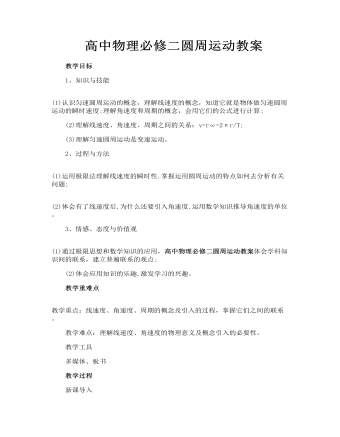
高中物理必修1教案高中物理必修二圆周运动教案
一、描述圆周运动的物理量 探究交流 打篮球的同学可能玩过转篮球,让篮球在指尖旋转,展示自己的球技,如图5-4-1所示.若篮球正绕指尖所在的竖直轴旋转,那么篮球上不同高度的各点的角速度相同吗?线速度相同吗? 【提示】 篮球上各点的角速度是相同的.但由于不同高度的各点转动时的圆心、半径不同,由v=ωr可知不同高度的各点的线速度不同.
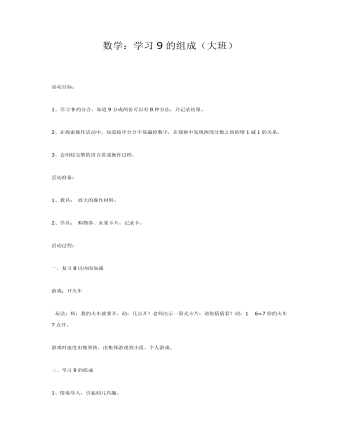
大班数学:学习9的组成课件教案
2、在探索操作活动中,知道按序分合不易漏掉数字,在观察中发现两部分数之间的增1减1的关系。3、会用较完整的语言讲述操作过程。活动准备:1、教具: 放大的操作材料。2、学具: 购物券、水果卡片,记录卡。活动过程:一、复习8以内的加减

人教版高中英语必修2Wildlife Protection说课稿3篇
When it comes to the students’ studying methods, I'd like to introduce my Ss first. The Ss have a good command of basic language points. They’re interested in learning English, and they take an active part in English class, so they will have fun in autonomous, cooperative and inquiry learning. I will just serve as a guide, showing them the way to explore how to make more progress in their English learning.Now it’s time for the most important stage of this lesson. My teaching procedures are arranged as follows:Step1.Leading-in (3 minute)Play a video of a wide variety of wildlife to introduce my topic. Step2. Speaking (12 minutes)We will use our textbook Page25. Let the Ss fast read the short paragraph to warm up. Ask them to talk about the report on some endangered wildlife in China with the dialogue patterns on the screen. Lastly, I will invite some groups to demonstrate their dialogues about saving wildlife in China.Step3.English play (3 minutes)Watch another video in praise of their excellent performance just now. It’s about Jack Chen’s(成龙)and Yang Ziqiong’s wildlife protection.Step4. Listening (twice 13 minutes)This time, I’ll ask the Ss to fill in the blanks of the monologue of the 2 movie stars above. Step5.Discussion (3 minutes)Which would you like to choose to wear, clothes made of cotton, artificial leather or animal skins? Why ?Step6. Summary (3 minutes)1. If there were no wildlife, there wouldn’t exist human beings. If the buying stops, the killing can, too.2. Animals are our friends. To love animals is to love ourselves. Stop hunting, killing and destroying wildlife.3. Let’s live in harmony with all the living things in the world. Step7. Music appreciation (3 minutes)Let the Ss appreciate the song Earth Song by Michael Jackson. Last but not the least, I will show you my blackboard design.

人教版高中英语必修2Computers说课稿3篇
一. 教材分析1. 本单元的中心话题是“计算机(Computers)”,内容涉及计算机的发展历史,计算机的应用等。本节课是该单元的第一课时,我将Warming up, Pre-reading and Comprehending这四部分整合为一节精读课。其中。Reading部分是题为WHO AM I?的文章,以第一人称的拟人手法介绍了计算机发长演变的历史和计算机在各个领域的应用,其主旨是表达计算机的发展变化之快以及在生活中用途之广。而Warming up部分以图片的形式展现了计算机的发展历程;Pre-reading中的问题和排序分别是为了预测语篇的内容和测试学生对计算机历史了解的情况;Comprehending则通过各项练习训练学生的阅读技能,从而加深对文章的理解。可见这几部分是一个有机的整体。2. 教学目标:1) 语言目标:重点词汇及短语:abacus, calculate, calculator, PC, laptop, PDA, robot, analytical, technological, universal, mathematical, artificial, intelligent, network, explore, in common, as a result.重点句子:a. My real father was Alan Turing, who in 1963 wrote a book to describe how computers could be made to work, and build a “universal machine” to solve any mathematical problem.

新人教版高中英语必修3Unit 2 Morals and Virtues教学设计二
Activity 41. Students complete the task of activity 4, then teachers and students check the answers. 2. The teacher organized the students to work together and asked them to use the tables and mind maps sorted out before to retold the important choices in Lin Qiaozhi's life and their resultsStep 5 Language points1. The teacher asks the students to read the text carefully, find out the core words and long and difficult sentences in the text and draw lines, understand the use of vocabulary, and analyze the structure of long and difficult sentences. 2. The teacher explains and summarizes the usage of core vocabulary and asks the students to take notes. 3. The teacher analyzes and explains the long and difficult sentences that the students don't understand, so that the students can understand them better. Step 6 Homework1. Read the text again, in-depth understanding of the text; 2. Master the use of core vocabulary and understand the long and difficult sentences. 3. Complete relevant exercises in the guide plan. 1、通过本节内容学习,学生是否理解和掌握阅读文本中的新词汇的意义与用法;2、通过本节内容学习,学生能否结合文本特点总结林巧稚的人生原则和人格品质特征;3、通过本节内容学习,学生能否针对人生抉择发表自己的看法;能否全面地、客观地、理性地看待问题,进而对道德和人性有更加深入的思考和理解。

新人教版高中英语必修3Unit 2 Morals and Virtues教学设计三
The joke set her crying.这个玩笑使她哭起来。Step 5 ReadingActivity 31. Students read the small text in activity 3. The teacher provides several small questions to check whether students understand the content of the text and the ideographic function of the -ing form in the text.*Where are those people?*Why did Dr Bethune come to China?*How did he help the Chinese people during the war?*What did Chairman Mao Zedong say about him?2. Ss try to rewrite some sentences using the -ing form. Then check the answers. When checking the answers, the teacher can ask different students to read the rewritten sentences and give comments.Answers:1. he became very interested in medicine, deciding to become a doctor.2. …after hearing that many people were dying in the war.3. Helping to organise hospitals, he taught doctors and nurses, and showed people how to give first aid./ He helped to organise hospitals, teaching doctors and nurses, and showing people how to give first aid.4. …praising Dr Bethune as a hero to be remembered in China.Step 6 PracticeActivity 4Students complete grammar activities 2 and 3 on page 69 of the workbook.Step 6 Homework1. Understand and master the functions and usage of the -ing form;2. Finish the other exercises in Using structures.1、通过本节内容学习,学生是否理解和掌握动词-ing形式作宾语补足语语和状语语的功能和意义;2、通过本节内容学习,学生能否正确使用动词-ing形式描述人物的行为、动作及其经历;3、通过本节内容学习,学生能否独立完成练习册和导学案中的相关练习。

新人教版高中英语必修3Unit 2 Morals and Virtues教学设计四
3.Teachers ask different groups to report the answers to the questions and ask them to try different sentence patterns.The teacher added some sentence patterns for students to refer to when writing.Step 4 Writing taskActivity 51.Write the first draft.Students first review the evaluation criteria in activity 5, and then independently complete the draft according to the outline of activity 4, the answers to the questions listed in the group discussion and report, and the reference sentence pattern.2.Change partners.The teacher guides the students to evaluate their partner's composition according to the checklist of activity 5 and proposes Suggestions for modification.3.Finalize the draft.Based on the peer evaluation, students revise their own compositions and determine the final draft.Finally, through group recommendation, the teacher selects excellent compositions for projection display or reading aloud in class, and gives comments and Suggestions.Step 5 Showing writingActivity 5T call some Ss to share their writing.Step 6 Homework1. Read the passage in this section to better understand the passage.2. Carefully understand the hierarchical structure of the article, and deeply understand the plot of the story according to the causes, process and results;3. Independently complete the relevant exercises in the guide plan.1、通过本节内容学习,学生是否理解和掌握阅读文本中的新词汇的意义与用法;2、通过本节内容学习,学生能否通过人物言行的对比分析道德故事的深层内涵;3、通过本节内容学习,学生能否根据故事的起因、经过和结果来深入理解故事的情节,从而了解文章的层次结构;4、结合现实生活案例发表自己的见解和看法,写一篇观点明确、层次分明的故事评论。

新人教版高中英语必修3Unit 2 Morals and virtues教学设计一
(2) students are divided into groups according to the requirements of activity 3. Each student shares a story of personal experience or hearing-witnessing kindness, and then selects the most touching story in the group and shares it with the whole class. Before the students share the story, the teacher can instruct them to use the words and sentence patterns in the box to express. For example, the words in the box can be classified:Time order: first of all, then, after that, later, finally logical relationship :so, however, although, butTeachers can also appropriately add some transitional language to enrich students' expression:Afterwards, afterwards, at last, in the end, eventuallySpatial order: next to, far from, on the left, in front ofOtherwise, nevertheless, as a result, therefore, furthermore, in addition, as well asSummary: in a word, in short, on the whole, to sum up, in briefStep 8 Homework1. Understand the definition of "moral dilemma" and establish a correct moral view;2. Accumulate vocabulary about attitudes and emotions in listening texts and use them to express your own views;3. Complete relevant exercises in the guide plan.1、通过本节内容学习,学生能否理解理解“道德困境”的定义;2、通过本节内容学习,学生能否通过说话人所表达的内容、说话的语气、语调等来判断其态度和情绪;3、通过本节内容学习,学生能否针对具体的道德困境发表自己的看法和见解,能否掌握听力理训练中的听力策略。
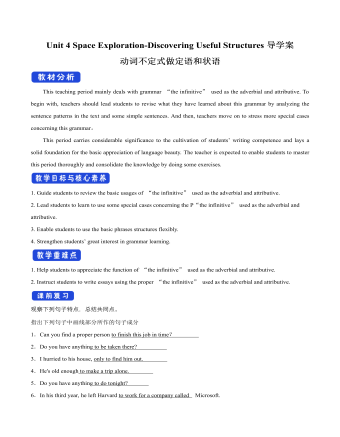
新人教版高中英语必修3Unit 4 Space Exploration-Discovering Useful Structures导学案
【点津】 1.不定式的复合结构作目的状语 ,当不定式或不定式短语有自己的执行者时,要用不定式的复合结构?即在不定式或不定式短语之前加 for +名词或宾格代词?作状语。He opened the door for the children to come in. 他开门让孩子们进来。目的状语从句与不定式的转换 英语中的目的状语从句,还可以变为不定式或不定式短语作状语,从而使句子在结构上得以简化。可分为两种情况: 1?当目的状语从句中的主语与主句中的主语相同时,可以直接简化为不定式或不定式短语作状语。We'll start early in order that/so that we may arrive in time. →We'll start early in order to/so as to arrive in time. 2?当目的状语从句中的主语与主句中的主语不相同时,要用动词不定式的复合结构作状语。I came early in order that you might read my report before the meeting. →I came early in order for you to read my report before the meeting.
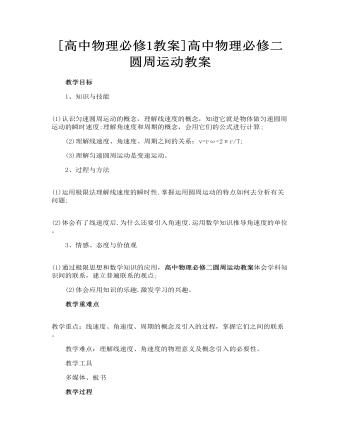
高中物理必修二圆周运动教案
1、知识与技能 (1)认识匀速圆周运动的概念,理解线速度的概念,知道它就是物体做匀速圆周运动的瞬时速度;理解角速度和周期的概念,会用它们的公式进行计算; (2)理解线速度、角速度、周期之间的关系:v=rω=2πr/T; (3)理解匀速圆周运动是变速运动。 2、过程与方法 (1)运用极限法理解线速度的瞬时性.掌握运用圆周运动的特点如何去分析有关问题; (2)体会有了线速度后.为什么还要引入角速度.运用数学知识推导角速度的单位。

中班数学:学习1-5的序数课件教案
2、发展幼儿思维的逻辑判断能力。活动准备:1、创设超市小货架的环境。2、动物及其食品小图片、房子图、笔等。活动过程:(一) 通过游戏“为小动物买礼物”理解序数。(序数可以从不同的方向数,从不同的方向数得出的结论会不同)1、自由探索:(1)引导幼儿以“到动物食品超市为小动物买礼物”的游戏形式到“超市”购物。 (要求记住在什么颜色的货架上买到货物的)(2)请个别幼儿告诉大家在什么颜色的格子里买到货物,并请其他幼儿猜一猜他是在第几个格格子里买到的东西。
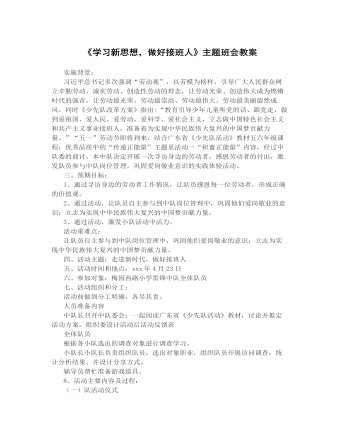
《学习新思想,做好接班人》主题班会教案
1、注重生成性,让队员成为活动的主人。这次活动,从确立活动主题,选择调查对象,设计活动过程,到写活动主持稿、准备活动道具等都是队员自主商量决定的。在活动过程中,能够发挥队员的自主性,以研究性学习,走访调查等方式开展活动,队员活动积极性较大。在小队展开走访调查时,队员们积极商量分工、设计问卷题目等活动。为了更好地采访劳动者,各个小队的队员各出奇谋,有一个小队队员们设计了网上调查问卷,发动家长、辅导员、其他人员完成问卷,然后对外卖小哥进行面谈访问,再两份调查结果进行比较分析。有一个小队的队员在采访时,注重把清洁工的工作以量化的形式去问,然后用数据来说话,他们还用录音记录采访的过程。有一个小队不仅边采访边拍照,还跟着保安叔叔进行站岗体验和学习防身拳……本次活动,除了课前采访调查和自行设计分享方式之外,其他的活动和环节都没有预设和尝试,而且每个小队的汇报的排练都是对其他小队都是保密的,因此本次活动课的内容都是现场生成的。